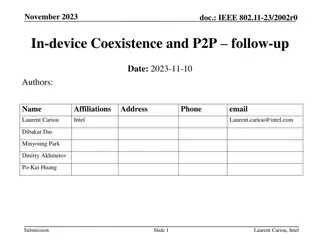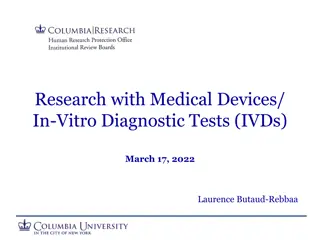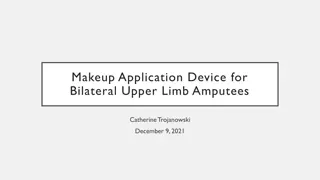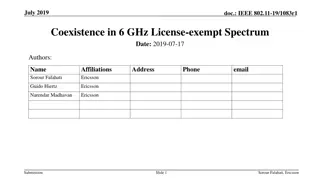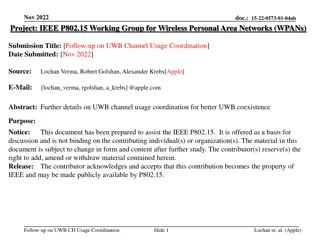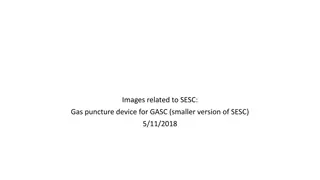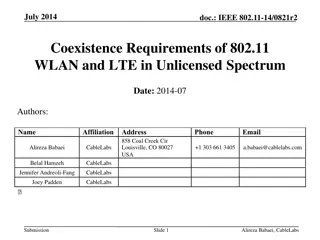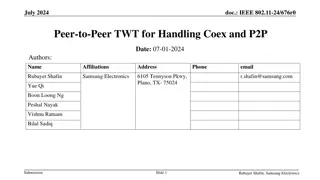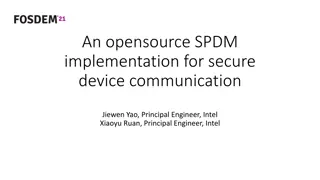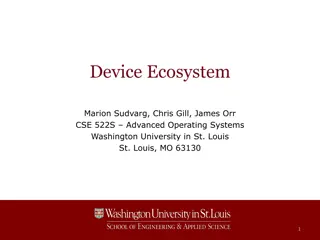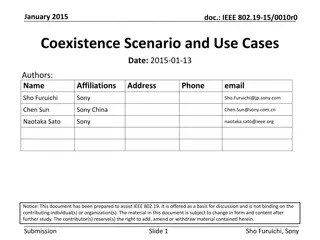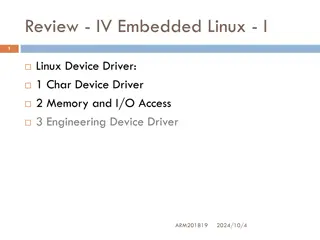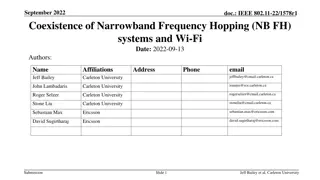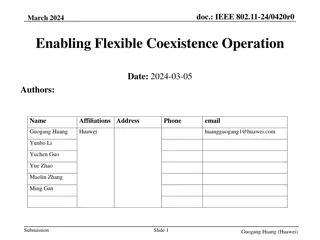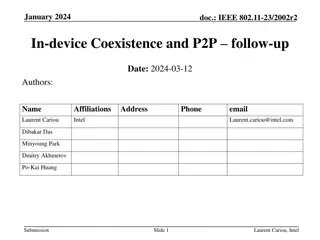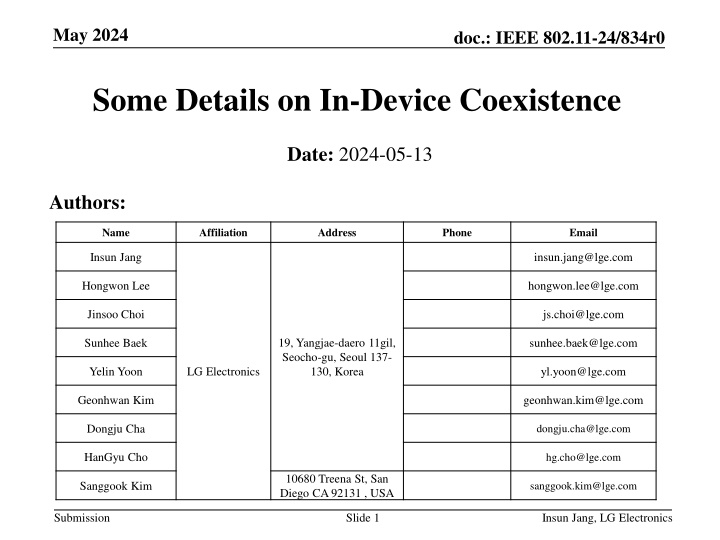
Exploring In-Device Coexistence in IEEE 802.11 Networks
Delve into the intricacies of handling in-device coexistence (IDC) issues in IEEE 802.11 networks, focusing on aperiodic IDC information. Learn about the occurrence of long-term and short-term IDC, how IDC impacts resource utilization, and the dynamic provision of IDC information. Discover the possible cases and implications of aperiodic IDC for efficient network management.
Download Presentation

Please find below an Image/Link to download the presentation.
The content on the website is provided AS IS for your information and personal use only. It may not be sold, licensed, or shared on other websites without obtaining consent from the author. If you encounter any issues during the download, it is possible that the publisher has removed the file from their server.
You are allowed to download the files provided on this website for personal or commercial use, subject to the condition that they are used lawfully. All files are the property of their respective owners.
The content on the website is provided AS IS for your information and personal use only. It may not be sold, licensed, or shared on other websites without obtaining consent from the author.
E N D
Presentation Transcript
May 2024 doc.: IEEE 802.11-24/834r0 Some Details on In-Device Coexistence Date: 2024-05-13 Authors: Name Affiliation Address Phone Email Insun Jang insun.jang@lge.com Hongwon Lee hongwon.lee@lge.com Jinsoo Choi js.choi@lge.com 19, Yangjae-daero 11gil, Seocho-gu, Seoul 137- 130, Korea Sunhee Baek sunhee.baek@lge.com Yelin Yoon yl.yoon@lge.com LG Electronics Geonhwan Kim geonhwan.kim@lge.com Dongju Cha dongju.cha@lge.com HanGyu Cho hg.cho@lge.com 10680 Treena St, San Diego CA 92131 , USA Sanggook Kim sanggook.kim@lge.com Submission Slide 1 Insun Jang, LG Electronics
May 2024 doc.: IEEE 802.11-24/834r0 Introduction Many presentations [1]-[10] already addressed the importance of handling unavailability due to in-device coexistence (IDC) and several methods to resolve the IDC issues In this contribution, we discuss some details on handling IDC by focusing on aperiodic IDC Info Submission Slide 2 Insun Jang, LG Electronics
May 2024 doc.: IEEE 802.11-24/834r0 Recap: In-Device Coexistence Basically, IDC can occur in a long-term or a short-term Long-term mostly refers to periodic/predictable IDC Info (e.g., Service Period) It would be similar to TWT, which requires some modifications for IDC SP Short term mostly refers to aperiodic IDC Info IDC Info indicates unavailability during indicated duration for Time and frequency resources Other resources (e.g., Nss, Tx/Rx parameters such as PPDU duration limit) Such unavailable resources make STA not to use its channels fully or partially We focus on aperiodic IDC Info that should be informed by affected STA dynamically in this contribution Submission Slide 3 Insun Jang, LG Electronics
May 2024 doc.: IEEE 802.11-24/834r0 Aperiodic IDC Aperiodic IDC can happen and its info can be provided E.g., based on discussions, a coexistence arbitrator can provide the event with Wi- Fi device (only if it is known) E.g., STA can provide the info until before informing a periodic IDC IDC Info can be informed by TXOP holder and/or TXOP responder dynamically after it happened, and can be carried in ICF/ICR at the beginning of TXOP It would depend on several technologies (e.g., (MU-)RTS/CTS, DPS, EMLSR) Several frames (e.g., QoS Data, BA) during TXOP Contents of Aperiodic IDC Info regarding unavailability They should be simply characterized due to overhead Time constraints (IDC start time and/or duration) We may simply include time-related Info only, which means that during the time, STA is fully unavailable IDC start time may be indicated only in Duration field [1][3] If needed, Frequency constraints (IDC subchannels) could be considered Slide 4 Submission Insun Jang, LG Electronics
May 2024 doc.: IEEE 802.11-24/834r0 Possible Cases of Aperiodic IDC If a STA recognizes IDC and wins an access to channel, it would decide TXOP length/bandwidth properly in the first place In a TXOP If a TXOP holder recognizes IDC will happen, It may truncate its TXOP if it will happen within a TXOP (baseline) It may inform TXOP responder(s) during that TXOP if it will happen after a TXOP If a TXOP responder recognizes IDC will happen within or after that TXOP, it may inform TXOP holder IDC Info during that TXOP Submission Slide 5 Insun Jang, LG Electronics
May 2024 doc.: IEEE 802.11-24/834r0 Overview of Design Details IDC Info mostly would be informed in unsolicited ways rather than it is directly solicited Therefore, it would be good to allow most frame exchanges in as common a manner as possible E.g., QoS Data/BAR-BA, Various variants of TF-Response, (MU-)RTS-CTS, Basically, new (A-)control field for IDC Info can be included in QoS Data/Null frames, Management frames (similar to BSR) TXOP holder or TXOP responder can flexibly inform IDC Info depending on frame exchanges, e.g., QoS Data/Null from TXOP holder/responder, Responding to Trigger frame ICF-ICR and BlockAck are discussed further in the next slides Submission Slide 6 Insun Jang, LG Electronics
May 2024 doc.: IEEE 802.11-24/834r0 ICF-ICR for IDC As most of ICFs, TF have considered as a powerful candidate e.g., BSRP/MU-RTS However, current ways of Responding to such TFs is not somewhat flexible to carry IDC, further in general more than one Control Infos (including IDC) in a timely manner E.g., in response to BSRP TF, the STA shall report BSR only; all MPDUs of the same frame type aggregated in the same AMPDU shall contain the same HT Control field (e.g., A-Control) in baseline Therefore, we should have mechanism(s) where how IDC info can be carried in ICR with solicited control info (e.g., BSR in response to BSRP) Further, we may generalize the way to include one or more control info(s) in several frames Submission Slide 7 Insun Jang, LG Electronics
May 2024 doc.: IEEE 802.11-24/834r0 ICR Considerations We can have several options, in response to TF Allow multiple frames including different A-controls (e.g., QoS Null frames) (Preferred) Allow a frame including one or more Control Info(s) (e.g., Action frame, BA (see next slide)) E.g., By having an Action frame for Control Info in response to BSRP TF, the Action frame can include BSR in A-control and other control info(s) in Body Submission Slide 8 Insun Jang, LG Electronics
May 2024 doc.: IEEE 802.11-24/834r0 BlockAck for IDC During frame exchanges, TXOP responder(s) can inform their IDC Info through a modified BA frame In terms of Compressed BA, We can add IDC/Control Info immediately after BA info with a presence indication; meanwhile, it may deliver IDC Info while keeping BA s functionalities In terms of Multi-STA BA, it should be carefully designed due to AID TID Info Depending on values of AID TID Info field, Per AID TID Info length is determined Therefore, we can use a special AID (e.g., 2007) while keeping existing values of TID/Ack type fields that will determine a container size including IDC Info (e.g., 2 octets + 4 octets) If we consider SU only, TID/Ack type can have other special values Different control information as well as IDC Info could be delivered if we generalize it Submission Slide 9 Insun Jang, LG Electronics
May 2024 doc.: IEEE 802.11-24/834r0 Additional Frames In response to (MU-)RTS, For RTS, TXOP responder may carry IDC Info by adjusting duration value, i.e., inform only IDC start time without any other info [1][3] For MU-RTS, TXOP responder cannot carry any IDC Info TXOP holder as a non-AP STA can inform TXOP responder(s) with its IDC Info For BAR, we can have the same way as compressed BAR Especially, in Trigger Frame as mobile AP, IDC info may be informed We can have another Common Info, i.e., Special User Info with another AID value Similarly, rather than IDC Info-specific User Info, it could accommodate different control information as well as IDC Info (i.e., ID + Information) [9], [11] Submission Slide 10 Insun Jang, LG Electronics
May 2024 doc.: IEEE 802.11-24/834r0 Several Issues on IDC Blindness After experiencing IDC, STA may lose medium which seems to be similar to that in the power saving mechanism (i.e., doze state -> awake state) We can simply reuse NAVSyncTimer or another new timer for IDC Failure Already mentioned in [3], i.e., STA (that was TXOP responder) can inform that BA couldn t be Txed due to IDC to avoid wrong rate adaptation On the other hand, TXOP holder may experience failure of Tx due to a sudden IDC and in that case TXOP holder may not increase CW Rules changes for TF In baseline, A non-AP STA that sends an HE TB PPDU as a response to a Basic Trigger frame shall set the Ack Policy Indicator subfield of the QoS Data frames or QoS Null frames to Normal Ack or Implicit BAR , which can be modified, e.g., allowing other Ack policies (due to IDC) Submission Slide 11 Insun Jang, LG Electronics
May 2024 doc.: IEEE 802.11-24/834r0 Conclusion We ve focused on aperiodic/unpredictable IDC IDC Info can be carried dynamically in ICF/ICR at the beginning of TXOP and several frames (e.g., QoS Data, BA) during TXOP by TXOP holder and TXOP responder It is expected that IDC Info mostly would be informed in unsolicited ways rather than it is directly solicited We also discussed the detail design of indicating IDC Info and several issues Mainly, focusing on A-control, ICF/ICR, BA to carry IDC Info (or further Control Info) Especially, we may have a direction of flexibly responding a TF to carry one or more Control Info(s) including IDC Info Submission Slide 12 Insun Jang, LG Electronics
May 2024 doc.: IEEE 802.11-24/834r0 Straw Poll 1 Do you agree to include the following into the 11bn SFD? 11bn defines a new Control ID in A-control to include the information regarding unavailability from in-device coexistence within a non-AP STA The information includes at least when the non-AP STA transmitting the information will be unavailable Signaling detail is TBD Submission Slide 13 Insun Jang, LG Electronics
May 2024 doc.: IEEE 802.11-24/834r0 Straw Poll 2 Do you agree to include the following into the 11bn SFD? 11bn defines a mechanism where in a frame in a response to a Trigger frame, the information regarding unavailability from in-device coexistence within a non-AP STA can be carried with the control information solicited from the Trigger frame The information includes at least when a non-AP STA transmitting the information will be unavailable Possible variant of the Trigger frame and the type of responding frame are TBD Signaling detail is TBD Submission Slide 14 Insun Jang, LG Electronics
May 2024 doc.: IEEE 802.11-24/834r0 Straw Poll 3 Do you agree to include the following into the 11bn SFD? 11bn modifies a BlockAck frame to include the information regarding unavailability from in-device coexistence within a non-AP STA The information includes at least when the non-AP STA transmitting the information will be unavailable The applied type of BlockAck frame is TBD Signaling detail is TBD Submission Slide 15 Insun Jang, LG Electronics
May 2024 doc.: IEEE 802.11-24/834r0 References [1] 23/1934, In-Device Interference Mitigation Follow Up [2] 23/1964, Coexistence Protocols for UHR [3] 23/2002, In-device Coexistence and P2P follow-up [4] 23/2026, Balanced In Device Coexistence [5] 23/2078, Coex Enhancement for XR Use Cases [6] 24/0094, Probe-Before-Talk and Unsolicited Unavailability Announcement for Co- ex Management [7] 24/0420, Enabling Flexible Coexistence Operation [8] 24/0436, SP Based In-Device Coexistence [9] 24/0494, In-device Coexistence Follow Up: Control Frame [10] 24/0509, Thoughts on Co-Ex and P2P for 11bn [11] 24/0042, Thoughts on Flexible Control frames Submission Slide 16 Insun Jang, LG Electronics


